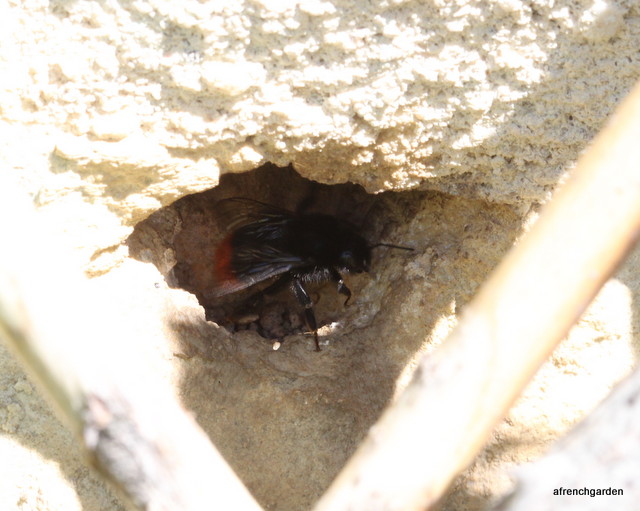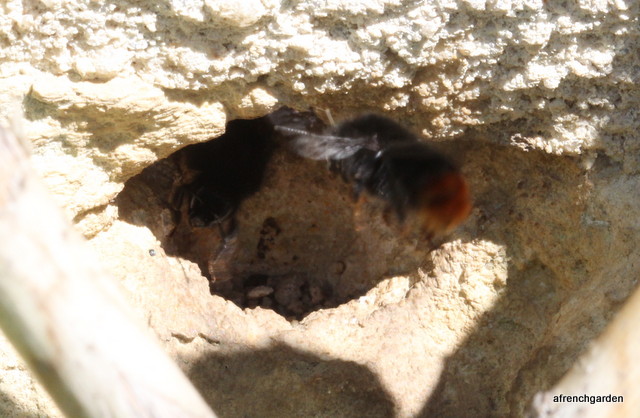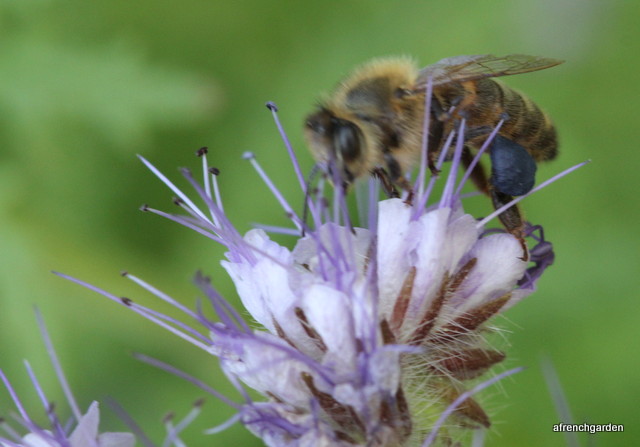We were having a coffee on the patio when my husband glanced up and said “What’s that on the rose branch?” I did not immediately see anything but then I noticed our couleuvre (Hierophis viridiflavus) draped over the branch, so I ran inside for the camera before she could slide of. I think it must be the same one as we saw in 2013 when she was still tiny, see Lodgers.
The rapid departure did not take place and I was given the task of gently prodding her with a stick. She did not budge, she was really enjoying her sunny bask. However, I persisted and eventually managed to get her to budge and she slid following the line of Madame Isaac Pereire’s branch to near the ground where she slid into a hole in the wall.
I was a bit concerned as it was the same hole being used by red tailed bumble bees (Bombus lapidarius) as a nest site. I have been keeping an eye on the nest since I saw the queen coming and going earlier in the year.
After the snake’s visit I set up my camera to watch the nest but the bees and the snake must be quite happy to share the same neighbourhood. There was plenty of coming and going with a bit of congestion at times.
It was nice to see the bumbles arriving with lots of pollen for the queen. The queen will not leave the nest now as she has hatched sufficient workers to keep her and her brood supplied with nectar and pollen to feed the new larval bees. I think the the hole must lead to the interior space between the thick old walls and provide plenty of room for all comers.
Talking about pollen – I have now forgiven the Phacelia for disappointing me with the lack of variety of pollinators compared to other flowers. Look at the colour of the pollen on the bumble bees legs!
This honey bee is going to be able to brighten up the stocks of pollen in her hive with lilac pollen too.
To be fair I do see some butterflies too, I think this one is probably a heath fritillary.
For me though, it is the poppies in the garden that steal the show these days.
I like to play “What’s your favourite poppy”. This game can be played on your own but it is better with other players. You have to decide on which poppy you think is the best. The poppy game can be continued by tying markers around your chosen poppies because after the flower passes one poppy seed head looks very much like another but with the markers the flower stems can be traced back so that you are certain to take only the seed from your chosen plant.
The “Choose the poppy” game continues on to the next year when you sow the seed and all the flowers that come up are nothing like the ones you chose the previous year. So the poppies get the last laugh, but the ones that do come up are just as astonishing and the game can be repeated for another year.
Ending on a happy note, on Wednesday we had a visit from a proud partridge. The partridges had been visiting us since last December (see Winter begins ) but recently only one of them had been coming into the garden to steal the bird food. This made us think that either one had had an accident or else might be sitting on eggs.
The chicks are very active and they were difficult to count but they have managed to raise eight although there was only one bird with them. I don’t know whether that means that the male has now left the female or if they take turns with the baby sitting.











I realise that it was always going to be hard for you to catch my interest after your posts about catching swarms of bees – I keenly await updates – but a snake? Okay, you got my attention 🙂 You’re really keeping the bar high on these posts!
What a garden you have. I love all your posts and read in awe (and a healthy dose of envy).
LikeLike
The snake is a non-venomous, common variety in these parts but I am sure this one lives with us although I see it rarely. They eat lizards and these are abundant in the garden so I don’t think it can have to work hard to survive. It as certainly very laid back and took a lot of poking to get it to slide back to its hole. Amelia
LikeLike
What a pretty snake – though not as pretty as the bees of course. I was a bit confused about why you wanted it to move, did you feel nervous about having it out in the open?
LikeLike
I was not at all nervous. I am rather fond of it. I just wanted to get a better look at it because I could not see it properly because of the way it had draped itself over the rose branch. It did not look so long when it was curled up but it must have been nearly two metres long. Amelia
LikeLike
Oh goodness, I must check my bumbles for purple pollen. 🙂
LikeLike
I love seeing all the different colours of pollen being gathered and trying to work out where they might have been. Amelia
LikeLiked by 1 person
Wonderful wildlife. The partridges are adorable.
LikeLike
The little chicks are really cute looking but she seemed a bit negligent in her care of them. It was up to them to follow her and she did not appear to be making sure that they were all there. Amelia
LikeLiked by 1 person
This looks like a whip snake, which we often saw in the garden in Spain. They aren’t venomous. Surely no need to stop them from sun-bathing? – especially when adorning the beautiful rose Mme. Isaac Pereire.
LikeLike
Quite right! It was not fair at all poking her with a stick when she was enjoying the sunshine. It is just that I don’t get to see her so often and I wondered how big she was. She was bigger than I expected nearly two metres long. In addition, I thought it was interesting that she made straight to the place I had last seen her. Amelia
LikeLike
Lovely post! You have quite the wildlife habitat in your home & garden.
LikeLike
Thank you. We do try to keep the wildlife in the garden but sometimes we have a problem if it is warm in the spring and the house martins take a fancy to nest in the beams inside the house. It means keeping the windows closed. Amelia
LikeLike
Great post. I’m dealing with a snake in my yard, trying to grab it and relocate it (my wife does not like snakes). So far it’s proven to be a difficult task; the think really moves, and I don’t want to hurt it.
LikeLike
I hope you know what kind it is, even this one would probably bite if I tried to grab it. I’m afraid I’m not well up on snake repellents but I’m sure there must be something. It is either that or trying to talk your wife into thinking of it as your new pet. Amelia
LikeLike
Predators are a natural repellant, but I don’t want those here either (unless it’s a hawk).
The snake probably keeps the field mice in check, so I don’t mind it here, but . . . yeah, not gonna fly as a pet (if snakes could fly, that is).
LikeLike
Great wildlife photos again, Amelia. And I like the idea of your poppy game, but I’m afraid I’m too ruthless…we aim for a very dark purple, nearly black single opium poppy, and ruthlessly rip out any flowers asap if they don’t live up to expectations! So far its worked in keeping the population pretty stable. But I risk criticism for my lack of tolerance….which is fine, and justified,
Best wishes
Julian
LikeLike
A nearly black opium poppy sounds stunning and it would certainly stand out in the garden at this time of year. It would look lovely with pale pink ones but I suppose that would ruin your chances for the next year. Amelia
LikeLiked by 1 person
There’s the rub…which is what I’m always telling Fiona, when she brings home new forms of say Honesty ( red) when we just have the white variety … Mind you times may change. I used to rip out all the orange forms of the native Welsh poppy, hoping to leave just yellow ones, but never achieved anything, so have given up. I’m gradually loosening my grip on things as I realise that ultimately there’s only quite modest control you can or should achieve in a garden. Your approach seems much more exciting!
Best wishes
Julian
LikeLiked by 1 person
I love that purple pollen… very fetching! And the baby partridges are sweet!
LikeLike
I’ll be looking out for the baby partridges but they look so fragile chasing after her. Amelia
LikeLiked by 1 person
What a great set of photos! Here in Australia, it is almost suicide to poke a snake with a stick….most are so poisonous that you really don’t want to alert them to your presence! I love poppies no matter what colour they come in, but it’s always fun to see what new combinations mother nature can provide
LikeLike
Luckily the only poisonous snake around here is the adder, which I would not poke and I have only seen once here, on a road and not in the garden and that took off very rapidly before I could get a photograph. I think I would keep away from snakes and concentrate on my poppies if I lived in Australia. Amelia
LikeLiked by 1 person
Now I wonder if bees ever sting snakes. Maybe they sense that the snake is no threat. I can’t picture a snake eating one.
The partridge looks nice and fat and happy and the poppies are beautiful!
LikeLike
I think the snake would be more attracted to the bumble bee nest with the larvae than the bees themselves. I think with so many lizards and probably small furry rodents around that the snake doesn’t work very hard to find its dinner. The bees would have no problem stinging it if it became a problem, probably they would not even lose their dard as the snake’s skin is taut not like our soft skin. Amelia
LikeLike
How lovely to have such a range of wildlife resident in your garden. The poppies are beautiful.
LikeLike
I am glad you like the poppies although they are starting to get a bit straggly now and I’ll have to leave them like that for a bit to collect the seed. Amelia
LikeLike
That pollen on the bumblebee legs is very beautiful!
LikeLike
The pinky/lilac shades of pollen always make me think of candy floss and old fashioned cake decorations. Amelia
LikeLike
A lovely post Amelia. What interesting creatures you have visiting your garden. I love poppies too.
LikeLike
Thank you. The poppies love the heat but now it is getting a bit too hot.
LikeLike
Wow – plenty going on, Amelia. I watched a gardening programme where they suggested marking the poppies you wished to save seed from but in my experience they don’t come true either. But I have managed to eradicate the doubles which I dislike and bees struggle to reach the pollen. D
LikeLike
I have some doubles but they are quite open and they have bag ties around them, but who knows what will happen next year.
LikeLike
You do have some interesting visitors to your garden. Poppies are some of my favourites too, I’m trying to encourage more into the garden each year.
LikeLike
I’ve always liked poppies but this year, looking at the black pollen stored in the bee comb, I realise how important they are for the bees. Amelia
LikeLiked by 1 person
I’d be in ecstasy if I found a snake in the garden! I love the purple pollen and the partridge (now there’s a tongue twister!). 😀
LikeLike
Purple pollen and a partridge makes a change from red leather, yellow leather! Amelia
LikeLike